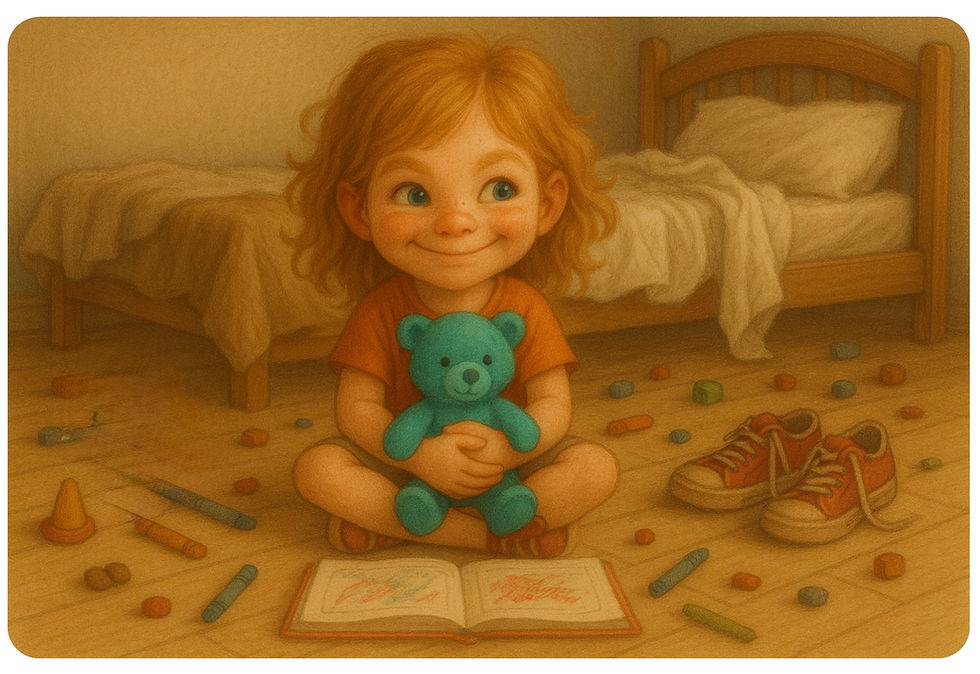How to Calm a Wild Child Without Resorting to a Tranquilizer Gun (Though, Honestly…): The Secret to Taming Your Chaos Gremlin
- Jennifer Tollefsrud

- Jun 5
- 4 min read

So, your kid is basically a Tasmanian devil wearing a backpack and a juice box. Congratulations—you’ve won the lottery of parenting: a #neurodiverse child. Maybe they’re rocking #ASD, flirting with #ADHD, or just wired in that special way that makes every day feel like you’ve been cast in a reality show called “Extreme Home Makeover: Nervous System Edition.” And sure, sometimes it seems like your kid’s only mission in life is to redecorate your walls with crayon murals and interpretive dance dents. But fear not, they’re not “broken.” They’re just “enthusiastically different”, which is a fancy way of saying their nervous system is powered by espresso and glitter.
Enter: #HeavyWork. No, we’re not talking about child labor (though if you’ve ever fantasized about your kid actually earning their keep by hauling mulch, you’re not alone). This is the kind of “work” #occupational therapists call #proprioceptiveinput, which is just a fancy term for “make your kid push something heavy so their brain stops acting like it’s auditioning for a horror movie.”
What the Heck Is Heavy Work? (A Parent’s Survival Guide)
Heavy work is any activity that reminds your kid they have limbs. For #neurotypical kids, this is automatic. For our chaos gremlins, it’s like their brain’s GPS is stuck on “scenic route.” Heavy work is the #pressurevalve for all that pent-up, feral energy. It’s not punishment, it’s nervous system regulation with a side of existential swirliness.
Examples of Heavy Work (Because Desperate Times Call for Desperate Measures):
Pushing a weighted cart (or, if you’re at home, a laundry basket full of your hopes and dreams)
Pulling resistance bands (or your own hair out, but Amazon sells the bands)
Wall sits, planks, or bear crawls (boot camp for kids, minus the medals and plus the occasional whining)
Rolling up like a burrito in a blanket (compression therapy: because sometimes you just need to wrap your problems in a tortilla and hope for the best)
Why It Works (The Neuroscience for Parents Who Are Barely Surviving):
Heavy work stimulates deep pressure receptors, which whisper sweet nothings to the brain’s fight-or-flight center (#amygdala, you dramatic diva). It’s like telling your brain, “Hey, you’re not actually being chased by a bear, unless you count your kid’s meltdowns.” Over time, these #exercises help your child’s nervous system build regulation skills, like muscle memory, but for not turning into a banshee over the seam on a sock.
For kids with #ADHD, #ASD, or sensory processing disorder (#SPD), #heavywork is the difference between brushing teeth and a full-blown existential crisis over “the wrong kind of mint.”
Which Therapy Bosses Use These Tricks? (And Where You Can Get In on the Action)
Occupational Therapy (#OT): The MVPs of sensory regulation. If your kid needs proprioceptive input, an OT will craft a plan involving all kinds of “fun” activities that look suspiciously like torture, but your kid will beg for more.
Sensory Integration Therapy: A sub-type of OT that targets sensory processing. Think swings, compression vests, obstacle courses, and crash pads if you’re feeling brave.
DIR/Floortime and Play Therapy: Less about burpees, more about combining movement with emotional attunement. Great for #coregulating and actually connecting with your chaos gremlin while keeping them from destroying the house.
Practical Routines You Can Actually Try at Home (Because You’re Not Getting Out of This Alive Otherwise)
Let’s say your kid turns into a gremlin after dinner. Here’s a bedtime routine that doesn’t involve bribing them with Pop-Tarts (unless, of course, you’re desperate):
Bedtime Burrito Routine:
Roll your kid up in a soft blanket like a Chipotle burrito (compression = calm, or at least less screaming).
Do a “steamroller” by gently rolling a soft ball or yoga bolster over them (pretend you’re a human rolling pin).
Add 10 minutes of bear crawls or crab walks beforehand for proprioceptive input (because nothing says “bedtime” like a workout).
Read a book upside down on a rocking chair while wearing a weighted blanket (for you too, you’ve earned it).
But Where Do I Get All This Stuff? (Because Your Kid Isn’t Going to Find This Themselves)
You don’t need a sensory gym in your basement (though, let’s be real, that would be amazing). Here’s where to find the goods:
Amazon, Etsy, and Therapy Supply Sites: Search for “sensory tools,” “weighted blankets,” “compression vests,” or “body sock.” Or just type “my child is a chaos noodle and I need help.” The algorithm knows.
Your OT’s Recommendation List: Most therapists have catalogs of affordable tools or DIY versions (sand in Ziplocs = homemade weights!).
Pinterest: It’s 80% lies, but some of those sensory obstacle courses are actually doable (if you’re willing to risk your sanity).
Final Thought: You’re Not Failing, You’re Just Parenting on Expert Mode
#Neurodiverse kids don’t need to be “fixed.” They need #support. #Tools. #Movement. #DeepPressure. And occasionally, a basket full of books to push up and down the hallway until their nervous system stops acting like it’s on Red Bull.
So the next time your kid punches the couch cushions or spins like a fidget spinner on espresso, try not to take it personally. Just hand them a weighted backpack, point toward the laundry basket, and say, “Push it till you find enlightenment.”
May you survive till bedtime, and don’t forget to keep an emergency can of frosting or chocolate bar stashed for emergency meltdowns… yours, not theirs. 🤫
Disclaimer: This post is not medical advice. If you want medical advice, ask your doctor, not your cousin’s Instagram.
*If you would like more information on nutrition and lifestyle changes or have questions, feel free to message me, or you can book a free Discovery call to see if I can help you.
Book at redtreelifeandwellnesscoaching.com or call/text 919-246-9905
or use this link to book directly on my calendar⬇️
#NeurodiverseNotBroken #HeavyWorkForHeavyFeelings #PushPullCrashRepeat #SensoryNeedsAreReal #ParentingOnHardMode #AutismParentingTools #ADHDRegulation #OTMagic #WeightedBlanketWisdom #HumanBurritoTherapy #SensoryProcessingSupport #BigFeelingsLittleBodies #CalmTheChaos #DIYSensoryGym #CrashPadCrew #FidgetAndFlourish #TantrumTamer #BurritoBeforeBed #RegulateDon’tRestrain #OccupationalTherapyRocks #ParentingWithProprioception #BearCrawlsBeforeBedtime #CompressionCuresMeltdowns #ChaosToCalm #TheLaundryBasketSolution #SensoryStrategies #NeurodiverseParenting #HeavyWorkForKids #ProprioceptivePower #AutismSupport #ADHDLife #SPDTools #WeightedBlanketAddict #OTKnowsBest #PushPullPray #ChaosWrangling101







Comments